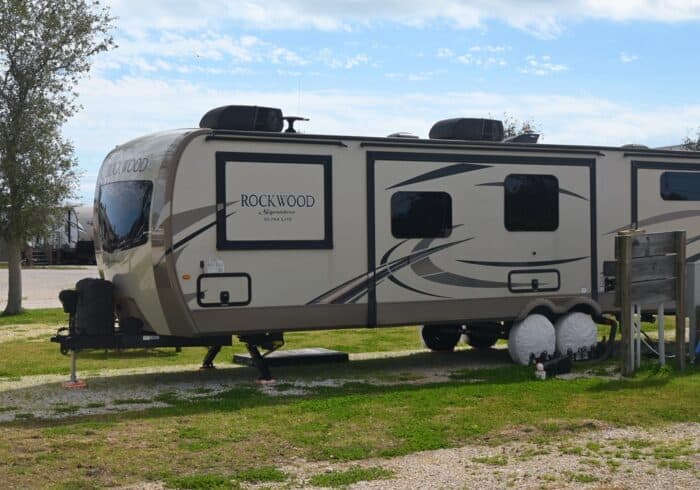Does RV AC Size Matter For Power Usage?
In some cases, you can run an RV AC using a regular wall outlet like the one found in a home or garage right from the get go.
But it usually depends on the size of the RV AC and the size of the outlet.
Related Product: Stop heat from getting in and cold air from getting out by using Camco RV Vent Insulators (click to view on Amazon).
For most standard size RV ACs (15k & 13.5K BTU) you will need to have a few adaptations done to the AC to make it work when plugged into a wall outlet.
For information on how to tell what size of RV AC you have check out this article.
You will also need to be plugged into a 20 amp outlet and not a standard 15 amp.
There is, however, a very small RV AC that can be run when an RV is plugged into a 15 amp wall outlet.
In this article, I’ll go over the basics of RV air conditioner power usage and how to make it so you can run your RV AC using a wall outlet and even an outlet on generators that are 2000 watts or more.
Related: What Is The Smallest RV AC? Reviews & Power Options
How Much Power Does An RV AC Actually Need?
An RV air conditioner uses a compressor and it needs a lot of power to get started.
When an RV AC turns on it draws a ton of power really fast to get the compressor going then the power usage drops.
That initial burst of power for the compressor is called a “surge.”
The electrical surge is the main reason why an RV AC cannot be powered by a regular wall outlet or a small generator.
The power used after the initial surge is called the “running watts.”
Even after the initial power surge, the running watts of most RV ACs are still pretty high. Around that of a full powered microwave.
A lot of the time even the running watts of a full sized RV air conditioner are more than a 15 amp wall outlet can handle.
That means it’s best to power an RV AC with a 20 amp wall outlet and adapter.
Here’s a table to give you a general idea of the power provided by different sizes of power outlets and the average power needs of the different sizes of RV air conditioners.
Outlet Watts
| Outlet Size in Amps | 15A | 20A | 30A (RV) | 50A (RV) |
| Watts | 1,800 | 2,400 | 3,600 | 12,000 |
RV AC Power Usage (in watts)
| RV AC Size (BTU) | 9,500 BTU | 13,500 BTU | 15,000 BTU |
| Avg. Surge Watts* | 1,600 | 3,500 – 3,900 | 4,000 – 4,300 |
| Avg. Running Watts* | 1,400 | 1,700 | 1,800 |
*Average numbers are used since each model with have slightly different watt usage. The watts in the table are to give a general idea for each RV AC size.
The most common size of RV AC on a camper is 13,500 BTU.
The least common size of RV AC on a camper is 9,500 BTU.
That means 99% of the time you will need at least a 20 amp house outlet and adapter to safely power an RV AC.
If your RV or van has a small 9.5K BTU RV AC that won’t surge over 1,800 watts you will be able to power it with a regular house outlet so long as nothing else in the camper is using power.
See Also: Can You Replace A 13,500 BTU RV AC With A 15,000 BTU RV AC?
How to Power an RV AC with a 20A Wall Outlet
It’s not as easy to power an RV AC with a wall outlet as many think.
If you turn on the AC when your camper is plugged in at home the breaker will most likely be tripped and you will lose power to the RV.
If the breaker doesn’t trip there could be some dangerous strain being put on the outlet and wiring.
So even if it does work, make sure you know why.
To safely power an RV with a wall outlet you will need a soft start kit, a 20 amp outlet, and a 20 amp RV adapter.
RV AC Soft Start Kits
Last update on 2024-04-25 / Affiliate links / Images from Amazon Product Advertising API
What is an RV AC Soft/Easy Start?
The RV AC compressor is the reason for the high surge watts, but there is a way you can minimize its initial power usage.
RV AC soft or easy starts are microprocessors you wire into the air conditioner’s electrical system.
The soft start changes the way the RV AC starts the compressor.
Instead of hitting it with a surge of power that starts the compressor instantly the soft start will work with the compressor’s motor and control the power input.
A compressor does not need to be turned to full speed right away, it can be slowly started with less power, which is what a soft or easy start processor will tell it to do.
See Also: Can I Run My RV AC When It’s Raining Or During Thunderstorms?
It’s easier on an RV AC compressor which makes it last longer. It also makes it a lot quieter when the AC starts up.
If you like to run your RV AC at night and the compressor start sound wakes you up, an easy start kit is a great way to reduce the noise so you can sleep better.
These practical kits are easy to install and they normally come with all of the electrical connectors you will need and detailed instructions.
How much will a soft/easy start reduce the RV AC power surge?
There are two companies that make popular RV AC soft/easy start kits. They work the same way but the power reduction can be a little different.
In general, no matter which kit you get the surge power will be reduced by around 65-70%.
Below is a table with the average power usage of different sizes of RV AC units with the surge watts reduced by 65%, which is the lowest percentage both brands of RV AC easy start kits can do.
Average RV AC Power Usage With Easy/Soft Start Kit Installed
| RV AC Size (BTU) | 9,500 BTU | 13,500 BTU | 15,000 BTU |
| Avg. Surge Watts | 1,600 | 3,500 – 3,900 | 4,000 – 4,300 |
| Avg. Surge Watts w/ Soft Start Installed* | 1,040 | 2,300 – 2,500 | 2,600 – 2,800 |
| Avg. Running Watts | 1,400 | 1,700 | 1,800 |
*65% of surge watts
This is just an estimation based on the average watts used by different brands of RV air conditioners.
The model on your camper might use more or less power. You can usually look up the max amps used with the model number or find it in the manual.
By reducing the surge watts by just 65%, which is the lowest reduction a soft start is capable of, you get really close to the 2,400 watts a 20 amp outlet can supply.
See Also: How To Easily Replace An RV AC With A Fan, Vent, or Skylight
In most cases, a soft start will be able to reduce the surge watts to 2,400 watts so they can be run with a 20 amp outlet.
Both of the companies actually advertise the ability to run one RV AC with a 20 amp wall outlet using its easy start kit.
That means you should be able to power an RV AC using a wall outlet so long as there is a soft start installed and you use a 20 amp outlet and adapter.
It’s also advertised that you can run 2 RV air conditioners with soft starts at the same time when plugged into 30 amp power.
This comes in handy if you have a 50 amp RV with multiple AC units and you stay somewhere that only has 30 amp hookups.

20 Amp Outlet
You can normally find a 20 amp outlet in the kitchen and garage.
They can be identified by the “T” blade on the left side.
The “T” shape, which looks like a sideways T, is necessary because a 20 amp plug has a straight blade and one sideways blade instead of two that are straight up and down.
20 Amp RV Adapter
20 amp RV adapters aren’t super common. Odds are the dog bone adapter you have right now is for a 15 amp wall outlet.
For a 30A RV, you will need this adapter by Parkworld (click to view on Amazon).
For a 50A RV, you will need to use 2 adapters since I couldn’t find a good 50A to 20A adapter.
First use a 50A to 30A adapter (click to view on Amazon).
Followed by the Parkworld 30A to 20A adapter (click to view on Amazon) that’s used for 30 amp campers.
Powering RV AC with a Generator
Big generators that are 4,000 watts or more can normally handle running an RV AC just fine.
That is unless your RV has a big 15k BTU air conditioner on the roof that requires something bigger like a 5,000 watt generator.
The companies that make the RV AC soft start kits say you can power an RV AC using a Honda EU2200i generator (click to view on Amazon) if the soft start is installed.
This is the smallest generator you should use to power a standard sized RV AC.
See Also: The Best Camping Gas Generators That Will Run Your RV AC
The Honda generator is recommended because it’s one of the few companies that is accurate with the watt output of its generators.
I recommend using something that has around 3,000 running watts because you don’t want to be pushing a generator too hard for long periods of time.
It’s also better to use a bigger generator if you live at higher altitudes.
When you plug into the generator make sure you are using an adapter that is rated for at least 20 amps, don’t use the 15 amp adapters.
Have any questions about powering an RV AC with a wall plug? Leave a comment below.






